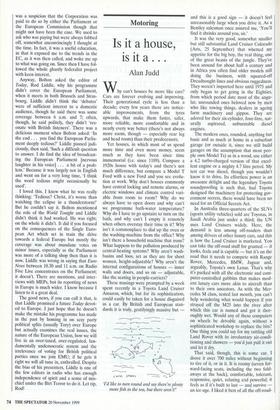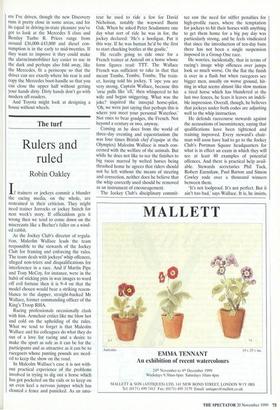Motoring
Is it a house, is it a . . .
Alan Judd
Why can't houses be more like cars? Cars are forever evolving and improving. Their generational cycle is less than a decade; every few years there are notice- able improvements, from the tyres upwards, that make them faster, safer, more reliable, more comfortable and in nearly every way better (there's not always more room, though — especially rear leg and head room) than their predecessors.
Yet houses, in which most of us spend more time and even more money, seem much as they have been since time immemorial (i.e. since 1189). Compare a 1920s house with today's and there's not much difference, but compare a Model T Ford with a new Ford and you see evolu- tion at work. Why don't houses commonly have central locking and remote alarms, or electric windows and climate control vari- able from room to room? Why do we always have to open doors and why can't we programme bath-water temperature? Why do I have to go upstairs to turn on the bath, and why can't I empty it remotely when others overstay their time in it? Why isn't it commonplace to dial up the oven or the washing-machine from the office? Why isn't there a household machine that irons? What happens to the pollution produced by central-heating systems? Why aren't wash- basins and loos, set as they are for short women, height-adjustable? Why aren't the internal configurations of houses — inner walls and doors, and so on — adjustable, like the seating in people-carriers?
These musings were prompted by a week spent recently in a Toyota Land Cruiser Amazon, which, but for its sophistication, could easily be taken for a house disguised as a car. By British and European stan- dards it is truly, gratifyingly massive but — 'I'd like to turn round and say there're plenty more fish in the sea, but there aren't!' and this is a good sign — it doesn't feel unreasonably large when you drive it. As a Bentley salesman once assured me, 'You'll find it shrinks around you, sir.'
It was the very good, somewhat smaller but still substantial Land Cruiser Colorado (Arts, 25 September) that whetted my appetite for the big boy, the real thing, one of the great beasts of the jungle. They've been around for about half a century and in Africa you often find older models still doing the business, with squared-off Dreadnought lines and obvious ruggedness.
They weren't imported here until 1975 and only began to get going in the Eighties, from which period date most of the angu- lar, unrounded ones beloved now by men who like towing things, dealers in ageing farm machinery and gippos. They are adored for their six-cylinder, four-litre, nat- urally aspirated, unburstable diesel engines.
The modern ones, rounded, anything but basic and as much at home in a suburban garage (or outside it, since we still build garages on the assumption that most peo- ple own Model Ts) as in a wood, use either a 4.2 turbo-charged version of that excel- lent engine or a mighty 4.7 litre petrol. My test car was diesel, though you wouldn't know it to drive. Its effortless power is an awesome delight and the legendary Toyota soundproofing is such that, had Toyota designed the machinery for protecting gov- ernment secrets, there would have been no need for an Official Secrets Act.
In Australia three-quarters of the SUVs (sports utility vehicles) sold are Toyotas, in Saudi Arabia just under a third; the UN uses Land Cruisers widely. Here, the demand is less among off-roaders than among drivers of other luxury cars, and this is how the Land Cruiser is marketed. You can take the off-road stuff for granted — it looks, feels and is capable — but it's on the road that it needs to compete with Range Rover, Mercedes, BMW, Jaguar and, arguably, Toyota's own Lexus. That's why it's packed with all the electronic and com- puter-controlled gubbins that makes mod- em luxury cars more akin to aircraft than to their own ancestors. As with the Mer- cedes M class, tested last month, you can't help wondering what would happen if you strayed off the M25 into the river after which this car is named and got it thor- oughly wet. Would any of these computers on wheels be drivable again, without a sophisticated workshop to replace the bits?
One thing you could say for my rattling old Land Rover with its involuntary air-condi- tioning and showers — you'd just pull it out and let it dry.
That said, though, this is some car. I drove it over 700 miles without beginning to tire of it, or in it. It is roomy (seven for- ward-facing seats, including the two fold- aways at the back), comfortable, tolerant, responsive, quiet, relaxing and powerful; it feels as if it's built to last — and survive an ice-age. I liked it best of all the off-road- ers I've driven, though the new Discovery runs it pretty close in some areas, and for its equal in driving-in-state pleasure you've got to look at the Mercedes S class and Bentley Turbo R. Prices range from around £36,000—£43,000 and diesel con- sumption is in the early to mid-twenties. If they want to improve it they could make the alarm/immobiliser key easier to use in the dark and perhaps also fold away, like the Mercedes, fit a periscope so that the driver can see exactly where his rear is and copy the Mercedes boot-handle so that you can close the upper half without getting your hands dirty. Dirty hands don't go with modern off-roaders.
And Toyota might look at designing a house without wheels.



























































































 Previous page
Previous page